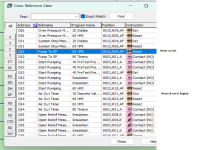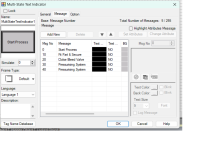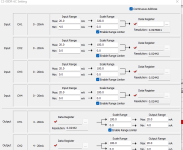Aljubovic
Member
Hello. I have been working on my first plc project for a while now. I just ordered all the parts that I need and before I did that, I created the program in do-more designer and simulated it. After debugging it the best I could and everything in the simulation worked, I transferred it all over to the click programming software so when my plc arrives, I can quickly start testing it.
This program is used to make an automated hydrostatic pressure testing unit for industrial hoses and has 4 devices.
1. pressure transmitter, 4-20mA, 0-2000psi
2. 3/2 Solenoid valve (for air supply cut off)
3. hydraulic solenoid valve (when overpressure detected, this will open and relief water pressure in hose)
4. ip current to pneumatic transducer, 4-20mA, 3-120psig
How it works is an operator will connect a hose to the system, then they will type in a pressure setpoint at which the hose will be tested at and also a time for how long to be held at that pressure. It does this by outputting the proper psi in the ip transducer to get the correct pressure output (Let's say the setpoint is 1000psi, the transducer would have to drive the pump with around 60-64 psi. The exact amount is calculated and then the ip transducer slowly ramps up to that pressure and holds it for the duration of the test. In this program the fluid supply valve and the pressure relief valve are manual, so when the operator presses the start button, a message appears on screen, they first need to open the fluid supply valve and wait for the hose to fill up with water, once water comes out the end of the hose (no more air inside the hose) the operator will close the relief valve, then they will press the okay button on the message that appeared on the hmi.
When the pressure test is done a message appears on screen to close the fluid supply valve and open the relief valve on the hose. Pressure will start dropping to 0 and then the program will reset.
If you want to actually simulate the program you will need to open data view in do-more and add in all pushbuttons, messages and setpoints to see what the program is doing. There are too many messages and outputs that I do not expect for anyone here to understand how this program fully works.
The do-more designer program has comments on most of the rungs to show what each one does.
Let me know if anyone finds any bugs, or rungs that will not work in my program for some reason.
Any help is appreciated. I will post the program for do-more and click down below.
Edit: There are more devices like hmi and mechanical devices, but I just put the main input and output devices. I will be using a c-more EA9-T6CL-R hmi.
This program is used to make an automated hydrostatic pressure testing unit for industrial hoses and has 4 devices.
1. pressure transmitter, 4-20mA, 0-2000psi
2. 3/2 Solenoid valve (for air supply cut off)
3. hydraulic solenoid valve (when overpressure detected, this will open and relief water pressure in hose)
4. ip current to pneumatic transducer, 4-20mA, 3-120psig
How it works is an operator will connect a hose to the system, then they will type in a pressure setpoint at which the hose will be tested at and also a time for how long to be held at that pressure. It does this by outputting the proper psi in the ip transducer to get the correct pressure output (Let's say the setpoint is 1000psi, the transducer would have to drive the pump with around 60-64 psi. The exact amount is calculated and then the ip transducer slowly ramps up to that pressure and holds it for the duration of the test. In this program the fluid supply valve and the pressure relief valve are manual, so when the operator presses the start button, a message appears on screen, they first need to open the fluid supply valve and wait for the hose to fill up with water, once water comes out the end of the hose (no more air inside the hose) the operator will close the relief valve, then they will press the okay button on the message that appeared on the hmi.
When the pressure test is done a message appears on screen to close the fluid supply valve and open the relief valve on the hose. Pressure will start dropping to 0 and then the program will reset.
If you want to actually simulate the program you will need to open data view in do-more and add in all pushbuttons, messages and setpoints to see what the program is doing. There are too many messages and outputs that I do not expect for anyone here to understand how this program fully works.
The do-more designer program has comments on most of the rungs to show what each one does.
Let me know if anyone finds any bugs, or rungs that will not work in my program for some reason.
Any help is appreciated. I will post the program for do-more and click down below.
Edit: There are more devices like hmi and mechanical devices, but I just put the main input and output devices. I will be using a c-more EA9-T6CL-R hmi.
Last edited:







